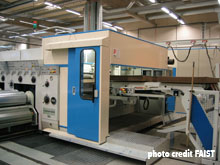Machinery soundproofing is an obligation arising from the application of the European Directive 2003/10/EC concerning the minimum safety and health requirements relating to the exposure of workers to the risks arising from physical agents (noise).

Machinery soundproofing |
In relation to the concepts introduced and developed in this document, thresholds must be considered:
- on the one hand, in terms of the level of daily exposure to noise, which is a time average and is expressed in dB (A)
- on the other hand in terms of peak acoustic pressure, which is an instantaneous maximum value and is expressed in dB (C)
Certain thresholds must in no case be exceeded for workers (at least: in France): respectively 87 dB(A) and 140 dB (C) for the indicators mentioned above.
Exceeding other thresholds, below, triggers the action: respectively 80 dB (A) and 135 dB (C) for the indicators mentioned above.
In workshops, the action is often to achieve the soundproofing of machines, which always leads (when it is possible) to the best results in terms of noise reduction (captured "at the source").
Of course, the performance of the soundproofing device to be considered is not the same when one is interested in an ultrasonic welding machine or a press for the manufacture of blocks, such sources of noise differing greatly by the frequency range corresponding to the maximum of their noise emissions, by their size and by the imperatives related to the management of the production equipment and its maintenance.
The common point of projects relating to the soundproofing of one or the other of these machines is that it requires know-how both specific and varied for the dimensioning of appropriate noise reduction devices, involving considerations in relation to acoustics of course, but also with ergonomics, mechanics or even heat transfers if heat dissipations must be taken into account, what is often the case.
The choices to be made as part of a machinery soundproofing project are not limited to the selection of insulation panels with a high sound reduction index and which are robust.
The technical imperatives to be considered when designing and constructing an enclosure (canopy) intended for the soundproofing of machines are sometimes antagonistic and require to find compromises vis-à-vis the functionalities of these constructions, generally metallic (e.g. based on modular panels).
Thus, sliding doors do not (in general) allow the achievement of acoustic performances as high as those that could be obtained with pivoting doors (their airtightness and therefore their acoustic attenuation is less), but they have on the other hand less travel, which is often appreciable in congested working environments (where space is limited) or with traffic lanes very close to the machines.
Thus, glazings do not have sound absorption properties comparable to those of the opaque parts of a canopy if this latter are made of absorbent panels (and therefore do not contribute as much to limit the amplification of sound levels inside) but are obviously necessary for process monitoring by operators and they must sometimes be arranged at very specific locations and have dimensions to be specially studied to allow optimal visibility.
Based on drawings (e.g. at the time of machine design) or when the machine is installed, a machine soundproofing project requires a careful and thorough study to develop the best solutions with a good price quality ratio.
The experience is a major asset for the design and construction of optimized soundproofing devices for machines, meeting all the expectations of manufacturers or end users.
The human resource of ITS has this experience and puts it at your service, for all your projects relating to machinery soundproofing.